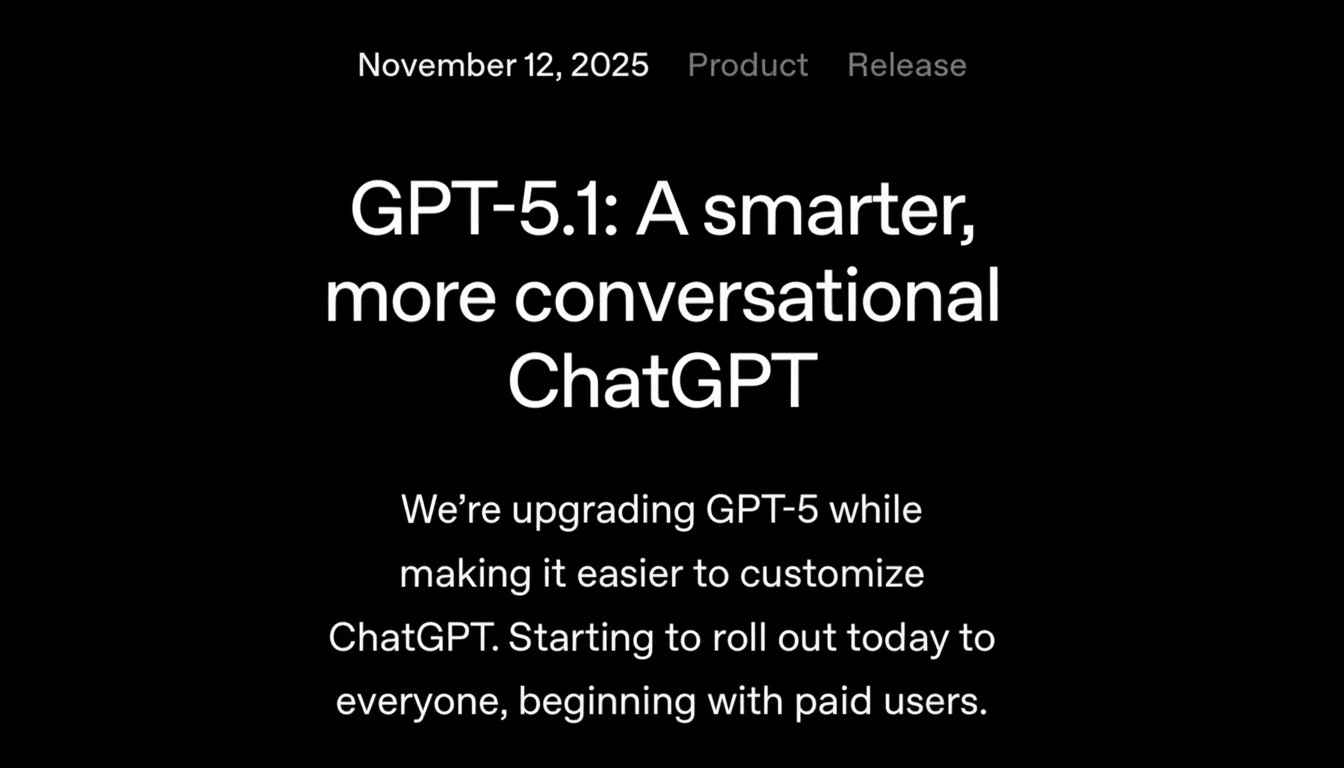OpenAI has released the latest version of its flagship assistant, ChatGPT 5.1, and it doubles down on two promises that users care about most: sharper answers and conversations that feel more natural.
The release fine-tunes the model’s understanding of questions, dials its tone in more precisely, and brings clearer choices for how the assistant should “sound,” all without losing speed on everyday tasks.
- What’s New in ChatGPT 5.1: Improvements and Updates
- Understanding the Instant and Thinking Models in ChatGPT 5.1
- Tone Controls and Personalities Get a Lift
- Smarter Answers: Fewer Errors and Clearer Reasoning
- Access, Rollout, and Transition for ChatGPT 5.1 Users
- Why It Matters: Reduced Friction and Consistent Results

What’s New in ChatGPT 5.1: Improvements and Updates
At its heart, 5.1 will help with reading comprehension and instruction following (which hopefully reduce the need for verbose prompts and repetitive clarifications). Responses are intended to pull us out of jargon on complicated issues and to be brief on simple ones. The model is also better at sensing when a question needs more reasoning and expends more effort on it, a bow to what AI researchers would call test-time compute scaling.
The pacing may be smarter, but the delivery is friendlier. OpenAI says that the result should be more conversational-sounding phrasing as a default, and fewer brusque or super-formal responses. It produces an assistant that is less like a search terminal and more akin to a responsive teammate—which is particularly helpful in the follow-ups where nuance counts.
Understanding the Instant and Thinking Models in ChatGPT 5.1
There are two versions of ChatGPT 5.1: GPT-5.1 Instant and GPT-5.1 Thinking. “The other difference is between the two avatars: we’re aiming to make Instant faster and more fluid with fewer interrupted conversations, being able to follow instructions better, etc. And it’s trained to detect when a simple answer will do, which could decrease latency and cut down on over-explaining.”
Thinking is designed for more challenging prompts—multi-step reasoning, difficult coding bugs, or ambiguous requirements. It dwells longer where it matters, then snaps back to a lighter touch once the problem is no longer in need of deep analysis. In practice, that’s quick tips for everyday “how do I?” questions and slower, more premeditated breakdowns for thorny logic or math.
Example: ask for a regular expression and Instant should look up the right snippet with some explanation; ask for an analysis around design trade-offs across architecture and Thinking should map ideas, edge cases, and risks with more structure.
Tone Controls and Personalities Get a Lift
Far more user-facing are the expanded personality presets—eight styles that influence voice, pacing, and warmth. Some of these traits were already there, but 5.1 further evolves them and adds better self-awareness: if you keep asking for another tone, the assistant can suggest changing style mid-conversation.

For teams, this is important beyond being in vogue. A consistent voice is both a branding and a compliance problem. Support leaders could standardize a “reassuring” or “professional” tone across channels, for example, while product teams could test which style elicits greater user satisfaction or completion rates. Companies like Gartner and Forrester have emphasized the role of tone consistency in customer experience results, and these controls provide admins a more precise dial by which they can tune.
Smarter Answers: Fewer Errors and Clearer Reasoning
OpenAI describes 5.1 as being smoother and more precise than ever. This appears in the code base as fewer off-by-one-type errors and clearer comments when reasoning is necessary. In data analysis, the model is more likely to declare assumptions and seek missing context. “Like any good assistant, for everyday use—drafts, summaries, and research—it should be able to reduce meandering explanations to a focused summary,” the researchers wrote.
Those stakes are high for scale: UBS estimated that ChatGPT had reached 100 million monthly active users early in its life, while crowd evaluations like LMSYS Chatbot Arena have emerged as informal scoreboards for model quality. Look for researchers at institutions like Stanford’s Human-Centered AI Institute to scrutinize 5.1’s reasoning improvements and clarity claims as it makes its way out.
Access, Rollout, and Transition for ChatGPT 5.1 Users
ChatGPT 5.1 is launching first for Pro, Plus, Go, and Business users, then free and logged-out access will follow closely behind. Enterprise and Education users get a seven-day early-access toggle before 5.1 goes default. Slow rollouts are meant to ensure service stability and give admins the opportunity to confirm validation of changes.
Previous generation GPT-5 models will be available for three months as part of legacy offerings, to facilitate side-by-side comparisons and staged migration. That window should provide enough time for teams to re-check prompts, update internal guides, and make sure that any tone or safety reviews cross over smoothly.
Why It Matters: Reduced Friction and Consistent Results
For individuals, 5.1’s biggest win is decreased friction: better understanding of intent, quicker replies for simple tasks, and richer reasoning when necessary. Tweakable tone and consistent reasoning depth are benefits for the organization, lowering up-front engineering overhead costs and bringing brand policy standards more strongly to bear—key considerations noted in NIST AI risk management framework and related guidance.
The bottom line: ChatGPT 5.1 is not a flashy rebrand; it’s a usability upgrade. So if OpenAI’s descriptions hold up under wider use, expect conversations to feel more human, responses to arrive closer to the way you meant them on the first try, and teams to spend less time wrestling it into the right voice.

